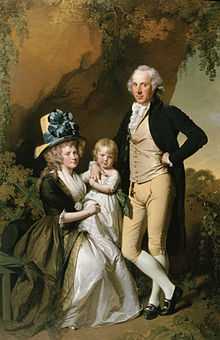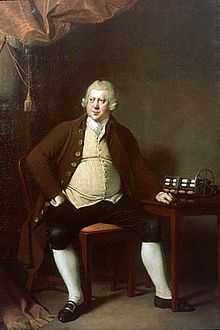Richard Arkwright junior

Richard Arkwright junior (19 December 1755 – 23 April 1843[1]), the son of Sir Richard Arkwright of Cromford, Derbyshire, was the financier (creditor) of Samuel Oldknow of Marple and Mellor and a personal friend. His son Captain Arkwright married Francis Kemble, daughter of the theatre manager Stephen Kemble.
Biography
Richard Arkwright junior was born in Bolton. His mother, Patience Holt, died when he was only a few months and his father, Richard Arkwright, raised him on his own until he was six, and married Margaret Biggensin, with whom he had a daughter, Susan. The couple divorced a few years later, but Richard Arkwright senior tried to follow the education of his children.[2][3]
Sir Richard had earlier patented the water frame, a roller-spinning machine powered by water, that turned textile spinning into a factory industry and in so doing he founded the factory system of manufacture.
Richard Arkwright junior followed in his illustrious father’s footsteps and he developed the factory system even further. He was an outstanding organiser of labour and machinery processing, ambitious, forceful and persevering.
The wealth of Arkwright, much greater than that of his father, was not only due to the textile industry. After his father died, much of the legacy was bequeathed to his daughter born of his second marriage, her grandchildren and various charities, while the rest, including a number of factories, was bequeathed to son Richard. He decided to invest in real estate and banks, and began to sell some factories to invest in government securities and real estate. This saved him from bankruptcy when a major economic depression descended upon Great Britain, after the defeat of Napoleon.[2]
In 1804 he became a partner in the bank of John Toplis, and when the latter died his death in 1829, he took full possession of the company and financed local lords, contractors and governmental plans: like his father, he financed important works in the public transportation sector and railways, including the Cromford Canal. At his death he was at the head of a fortune amounting to over three million pounds, which made him the richest British man from the bourgeoisie.[4]
Arkwright was the High Sheriff of Derbyshire in 1801.[5][6]
His son Richard (1781–1832) was a Member of Parliament (MP) for Rye from 1813 to 1818, and from 1826 to 1830.[7]
Portrait

Joseph Wright of Derby painted portraits of the father and his son, the latter along with the rest of the family. These two works illustrate the difference in wealth between the two generations. The father is sitting on an ordinary chair, behind his invention, the source of his new social status, whereas the other painting represents Richard junior, with his wife Mary and daughter Anne, all dressed in expensive clothes to the latest fashion with a view of the park of the family estate.
The painting of Richard junior and his family, painted in 1790, was intended as a pendant to Wright's portrait of Sir Richard, and was thought the best of the four paintings which hung in the Arkwrights family estate dining room at Willersley Castle. This painting was on loan and in the collection of Derby Museum and Art Gallery, where it was exhibited next to the one representing his father.[4] The painting was sold at Sotheby’s on 29 November 2001.[8]
In 2003, the painting was to be moved to the United States but the Derby Museum launched a petition to keep it in its home country. It is a cornerstone to the society.[9] The Arkwright Society, which was also concerned about the departure of the painting, took an active part in this campaign and the picture eventually remained in England.[10]
References
- ↑ http://www.cromfordvillage.co.uk/arkwrights.html
- ↑ 2.0 2.1 David Jenkins (2001). "Quiet Millionaire".
- ↑ The Arkwright Family in Cromford Cromford Village
- ↑ 4.0 4.1 "The Arkwrights". Retrieved 24 August 2011.
- ↑ Burkes Genealogical and Heraldic History of the Landed Gentry (1847)
- ↑ Plantagenet Roll of the Blood Royal, Marquis of Ruvigny, 1994, ISBN 0-8063-1434-6, accessed 11 September 2008
- ↑ Fisher, David R. (2009). D.R. Fisher, ed. "ARKWRIGHT, Richard (1781-1832), of Normanton Turville, Leics. and Sutton Hall, Derbys". The History of Parliament: the House of Commons 1820-1832. Cambridge University Press. Retrieved 17 June 2014.
- ↑ Derbyshire.gov.uk Accessed 2 June 2008
- ↑ Why this work should be saved Daily Telegraph 7.7.2003
- ↑ Meeting John Arkwright Arkwright Society 2004
| Honorary titles | ||
|---|---|---|
| Preceded by Eusebius Horton of Catton Hall |
High Sheriff of Derbyshire 1801–1802 |
Succeeded by Thomas Prinsep of Croxall Hall |
| ||||||||||||||||||||||||||||||||||||||||||||||||||||||